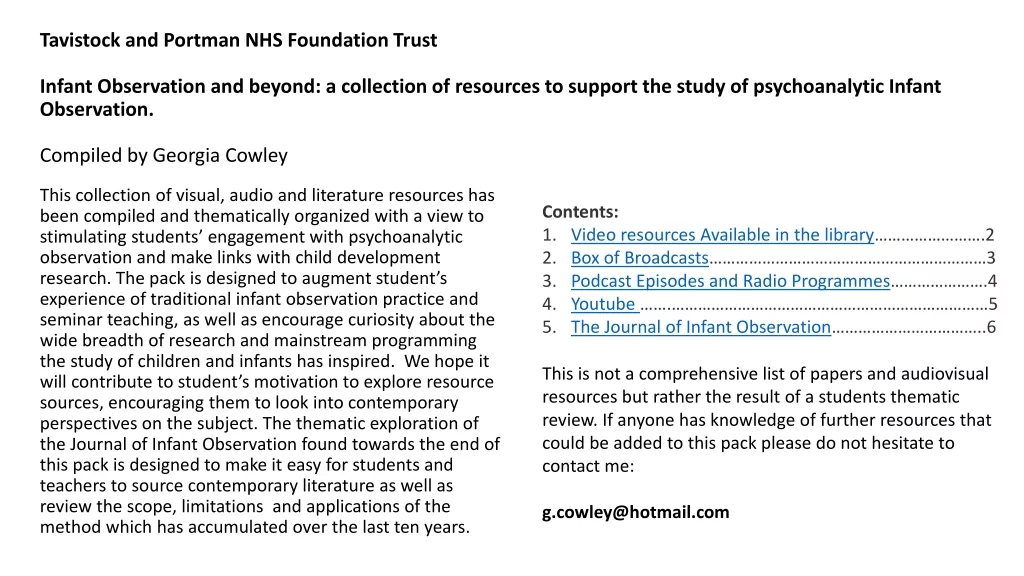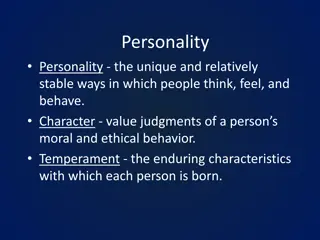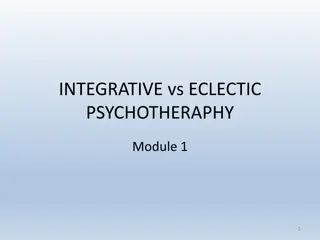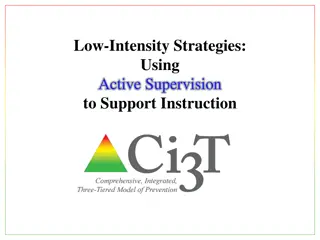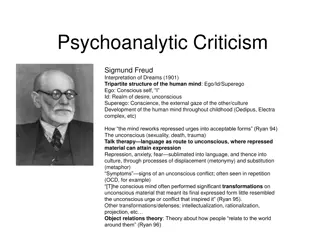Psychoanalytic Supervision: Integrative Approach and Practical Guidance
This comprehensive overview by Nancy McWilliams, PhD, explores various aspects of mental health supervision, including different styles of supervision, ethical considerations, and individual differences. She addresses the historical context, psychological evaluation in treatment progress, and the importance of integrating technique with broader developmental focus. The book aims to enhance supervisees' understanding and utilization of supervision for professional growth.
Download Presentation

Please find below an Image/Link to download the presentation.
The content on the website is provided AS IS for your information and personal use only. It may not be sold, licensed, or shared on other websites without obtaining consent from the author.If you encounter any issues during the download, it is possible that the publisher has removed the file from their server.
You are allowed to download the files provided on this website for personal or commercial use, subject to the condition that they are used lawfully. All files are the property of their respective owners.
The content on the website is provided AS IS for your information and personal use only. It may not be sold, licensed, or shared on other websites without obtaining consent from the author.
E N D
Presentation Transcript
DPE Education Forum on Teaching Supervision American Psychoanalytic Association Annual Conference February 1, 2023 Nancy McWilliams, PhD Visiting Professor Emerita Graduate School of Applied & Professional Psychology Rutgers, the State University of New Jersey
Disclosure Slide Disclosure Slide Nancy McWilliams has no conflicts of interest to disclose, beyond her hope that this presentation may interest participants in purchasing one or more books from which she earns royalties.
Learning objectives Learning objectives After this workshop, participants will be able to: 1. Describe ten areas of overall mental health relevant to supervision; 2. Describe two styles of supervision that may be damaging as well as two alternative styles that benefit the supervisory matrix.
Guilford Publications, 2021 Guilford Publications, 2021
Why I wrote this book: Why I wrote this book: In response to the need for an integrative text on supervision from a psychoanalytic perspective; In response to pressures on training programs to provide training in clinical supervision; As a counteractive to what I see as an overemphasis on skills- training and focus on technique without the contextualization of technique within a broader educational and professional developmental focus. Because my own experiences as supervisor and consultant are unusually diverse and extensive.
Outline of the book Outline of the book Chapter 1: Chapter 2: Chapter 3: Chapter 4: Chapter 5: Chapter 6: Chapter 7: Chapter 8: Chapter 9: Overview Historical background of psychoanalytic supervision Psychological vital signs : Evaluating progress in treatment Individual supervision and consultation Group supervision and consultation Supervision and ethics: The larger context Supervision in psychoanalytic institutes Individual differences and specific supervisory challenges Getting the most out of supervision: For supervisees
History of Psychoanalytic Supervision: History of Psychoanalytic Supervision: Milestones, chronologically Milestones, chronologically Freud said little about supervision and was notably non-dogmatic about how therapy should be done, beyond urging colleagues not to have sex with patients and not to try to be prophet, savior, or redeemer to them (1923, p. 50). He did assume that the best education for a therapist would be the person s own experience in psychoanalytic treatment. The Berlin model (Eitingon) and the Budapest model (Ferenczi); The beginning of research on supervision (Ekstein & Wallerstein, 1958) and the discovery of the parallel process; The eventual emphasis on the supervisory alliance (e.g., Sarnat, 2015); that is, the process rather than the content of supervision. The development of empirical research across theoretical orientations.
Historical Tensions Historical Tensions To teach or to treat? To pass on techniques and skills or to foster the supervisee s growth? Should psychotherapy be taught as a science or as an art?
Category mistake? Category mistake ? Methodological requirements for randomized controlled trials: Isolate variables: choosing people with one clear disorder not comorbid with anything else; Take objective measures of observable symptoms for a baseline; Manualize interventions; Limit the time period of the study; Evaluate improvement by changes in observable symptoms. Necessary for research but often currently applied uncomfortably to clinical practice and the evaluation of therapeutic progress
What psychological vital signs do supervisors What psychological vital signs do supervisors teach clinicians and their patients to monitor? teach clinicians and their patients to monitor? The following elements of psychological wellness are derived from both clinical reflection and empirical studies of capacities involved in overall mental health. Although most of these concepts emerged from psychoanalytic clinical thinking, and were influenced by earlier philosophical and spiritual writings, roughly equivalent terms have been used by contemporary therapists who do not identify with the psychoanalytic tradition. Lingiardi, V., & McWilliams, N. (Eds.) (2017). Psychodynamic Diagnostic Manual, 2nd. ed. (PDM-2). New York: Guilford.
Vital signs of patient progress, supervisee Vital signs of patient progress, supervisee growth, and deepening supervisory alliance growth, and deepening supervisory alliance 1. Safety and increased attachment security; 2. Self- and object constancy; 3. Sense of agency/self-efficacy/autonomy; 4. Reliable and realistic self-esteem; 5. Resilience, flexibility, affect regulation; 6. Reflective function (insight) and mentalization; 7. Comfort in both communality and individuality; 8. Vitality; 9. Acceptance, forgiveness, gratitude; 10. Love, work, and play.
1. Increased sense of interpersonal safety 1. Increased sense of interpersonal safety Security operations (Harry Stack Sullivan); Basic Trust (Erik Erikson); Attachment Security (John Bowlby); Epistemic Trust (Peter Fonagy).
Relevant References Relevant References Bowlby, J. (1969). Attachment and Loss: vol. I. Attachment. New York: Basic Books. Bowlby, J. (1973). Attachment and Loss: vol. II. Separation. New York: Basic Books. Mikulincer, M., & Shaver, P. (2007). Attachment in Adulthood: Structure, Dynamics, and Change. New York: Guilford. Wallin, D. (2007). Attachment in Psychotherapy. New York: Guilford. Slade, A., & Holmes, J. (2019). Attachment and psychotherapy. Current Opinion in Psychology, 25, 152-156. Cozzarelli, C., Karafa, J. A., Collins, N. L., & Tagler, M. J. (2003) Stability and change in adult attachment styles: associations with personal vulnerabilities, life events. and global construals of self and others. Journal of Social & Clinical Psychology, 22(3). Published Online:1 Jun 2005 https://doi.org/10.1521/jscp.22.3.315.22888 Fraley, C. R., & Roisman, G. I. (2019). The development of adult attachment styles: Four lessons. Current Opinion in Psychiatry, 25, 26-30. Theisen, J. C., Fraley, C. R., Hankin, B. L., Young, J. F., & Chopik, W. J. (2019). How do attachment styles change from childhood through adolescence? Findings from an accelerated longitudinal Cohort study. Journal of Research in Personality, 74, 141-146. Eubanks, C. F., Muran, J. C., & Safran, J. D. (2018). Alliance rupture repair: A meta- analysis. Psychotherapy, 55(4), 508 519. Levy, K. N., & Johnson, B. N. (2019). Attachment and psychotherapy: Implications from empirical research. Canadian Psychology/Psychologie canadienne, 60(3), 178 193.
Cassidy, J., & Shaver, P. R. (2016) Cassidy, J., & Shaver, P. R. (2016) Product Details
2. Increased feeling of personal continuity 2. Increased feeling of personal continuity Sense of going on being (Donald Winnicott); Identity integration (Eric Erikson); Self-constancy (Margaret Mahler); Self-cohesion (Heinz Kohut); Standing in the spaces (Philip Bromberg).
Relevant References Relevant References Solnit, A. (1982). Developmental perspectives on self and object constancy. Psychoanalytic Study of the Child, 37: 201-220. Erikson, E. (1968). Identity, youth and crisis. New York: Norton. Kernberg, O. F. (1984). Severe personality disorders: Psychotherapeutic strategies. New Haven, CT: Yale University Press. Bromberg, P. M. (1998). Standing in the spaces: Essays on clinical process, trauma and dissociation. Hillsdale, NJ: Analytic Press. Caligor, E., Kernberg, O. F., Clarkin, J. F., & Yeomans, F. E. (2018). Psychodynamic therapy for personality pathology: Treating self and interpersonal functioning. Washington, DC: American Psychiatric Publishing. Clarkin, J. F., Caligor, E., Stern, B., & Kernberg, O. F. (2019). Manual for the Structured Interview of Personality Organization Revised. https://www.borderlinedisorders.com/assets/STIPORmanual.July2019FINALMod.pdf
3. Increased sense of agency 3. Increased sense of agency Autonomy (Erik Erikson, David Shapiro, Steven Mitchell); Internal locus of control (Julian Rotter); Effectance (Robert White); Self-efficacy (Albert Bandura).
Relevant References Relevant References Erikson, E. (1950). Childhood and society. New York: Norton. Shapiro, D. (1981). Autonomy and rigid character. New York: Basic Books. Mitchell, S. A. (1997). Influence and autonomy in psychoanalysis. Hillsdale, NJ: The Analytic Press. Maddux, J. E. (2013). Self-efficacy, adaptation, and adjustment: Theory, research, and application. New York: Springer.
4. Increasingly realistic and reliable self 4. Increasingly realistic and reliable self- -esteem esteem Stable ego ideal (Sigmund Freud); Feeling of adequacy (Alfred Adler); Positive self-regard (Carl Rogers); Healthy narcissism (Heinz Kohut).
Relevant References Relevant References Rogers, C. R. (1961). On Becoming a Person. Boston: Houghton- Mifflin. Kohut, H. (1971). The analysis of the self. New York: International Universities Press. Kohut, H. (1977). The restoration of the self. New York: International Universities Press. Reich, A. (1986). Pathologic forms of self-esteem regulation. In A. P. Morrison (Ed.), Essential papers on narcissism (pp. 44-60). New York: New York University Press. Westen, D.(1990). The relations among narcissism, egocentrism, self-concept, and self-esteem. Psychoanalysis andContemporary Thought, 13(2):183-239. Friedman, R. C., & Downey, J. I. (1999). Internalized homophobia and gender-valued self-esteem in the psychoanalysis of gay patients. Psychoanalytic Review, 86(3), 325-347.
5. Increased Resilience, Flexibility, Affect Regulation 5. Increased Resilience, Flexibility, Affect Regulation Ego strength (Anna Freud, Erik Erikson, Leopold Bellak); Conflict-free sphere of the ego (Heinz Hartmann); Maturity and flexibility of defenses (Otto Kernberg); Resilience (literature on trauma, especially in children); Affect regulation (Silvan Tomkins); Affect tolerance (Henry Krystal); Emotion regulation (Marsha Linehan); Affect modulation (Elliot Jurist).
Relevant References Relevant References Tomkins, S. S. (1995). Script theory. In E. V. Demos (Ed.), Exploring affect: The selected writings of Silvan Tomkins (pp. 312-388). New York: Cambridge University Press. Matsumoto, D., Keltner, D., Shiota, M. N., O'Sullivan, M., & Frank, M. (2008). Facial expressions of emotion. In M. Lewis, J. M. Haviland-Jones, & L. F. Barrett (Eds.), Handbook of emotions (pp. 211 234). New York: Guilford. Demos, E. V. (2019). The affect theory of Silvan Tomkins for psychoanalysis and psychotherapy. New York: Taylor & Francis. Panksepp, J. (2004). Affective neuroscience: The foundations of human and animal emotions. New York: Oxford. Matsumoto, D., Keltner, D., Shiota, M. N., O'Sullivan, M., & Frank, M. (2008). Facial expressions of emotion. In M. Lewis, J. M. Haviland-Jones, & L. F. Barrett (Eds.), Handbook of emotions (pp. 211 234). New York: Guilford. Demos, E. V. (2019). The affect theory of Silvan Tomkins for psychoanalysis and psychotherapy. New York: Taylor & Francis. Stefana, A. (2017). Psychoanalytic concepts in historical perspective: History of countertransference from Freud to the British Object Relations School. New York: Routledge. Mucci, C. (2018). Borderline bodies: Affect regulation for personality disorders. New York: Norton.
6. Reflective Function and Mentalization 6. Reflective Function and Mentalization Theory of mind (Ren Descartes); I and Thou (Martin Buber); Observing ego (Sigmund Freud); Search for meaning (Viktor Frankl); Insight (Robert Waelder, Heinz Hartmann, Anna Freud); Capacity for self-reflection (Lawrence Josephs); Reflective function and mentalization (Peter Fonagy); Recognition (Jessica Benjamin); Integrated superego (Sigmund Freud); Mature sense of morality (Otto Kernberg); Moral orientation (Charles Taylor).
Relevant References Relevant References Buber, M. (1923). I and Thou, tr. W. Kauffman. New York: Scribner & Sons, 1970. Fenichel, O. (1945). The psychoanalytic theory of neurosis. New York: Norton. Kernberg, O. (1984). Severe personality disorders: Psychotherapeutic strategies. New Haven: Yale University Press. Benjamin, J. (1988). The Bonds of Love. New York: Pantheon Fonagy, P., Gergely, G., Jurist, E., & Target, M. (2002). Affect regulation, mentalization, and the development of the self. New York: Other Press. Bateman, A., & Fonagy, P. (2004). Psychotherapy for borderline personality disorder: Mentalization-based treatment. London: Oxford University Press. Jurist, E., Slade, A., & Bergner, S. (2008). Mind to Mind: Infant Research, Neuroscience, and Psychoanalysis. New York: Other Press. McWilliams, N. (2011). Psychoanalytic diagnosis: Understanding personality structure in the clinical process, 2nded. New York: Guilford. Jurist, E. (2019). Minding emotions. Cultivating mentalization in psychotherapy. New York: Guilford.
Elliot Jurist, 2019 Elliot Jurist, 2019
7. Comfort in both Individuality and Community 7. Comfort in both Individuality and Community Introversion vs. extroversion (Carl Jung); The ocnophil vs. the philobat (Michael Balint); Autonomy vs. surrender (Emmanuel Ghent); Closeness vs. distance (Stephen Mitchell, Deborah Luepnitz); Self-definition vs. self-in-relationship (Sidney Blatt); Individualism vs. collectivism (literature on cultural difference).
Relevant References Relevant References Jung, C. G., & Baynes, H. G. (1921). Psychological types or the psychology of individuation. London: Kegan Paul. Balint, M. (1945). Friendly expanses Horrid empty spaces. International Journal of Psycho-Analysis, 36, 225-241. Blatt, S. J. (2004). Experiences of depression: Theoretical, clinical, and research perspectives. Washington, DC: American Psychological Association. Blatt, S. J. (2008). Polarities of experience: Relatedness and self-definition in personality development, psychopathology, and the therapeutic process. Washington, DC: American Psychological Association. McGoldrick, M., Giordano, J., & Garcia-Preto (Eds.) ( (2005). Ethnicity and family therapy (3rded.). New York: Guilford. Akhtar, S. (Ed.) (2010). Freud and the Far East: Psychoanalytic perspectives on the people and culture of China, Japan, and Korea. Northvale, NJ: Jason Aronson. Boyd-Franklin, N. (2006). Black families in therapy: Understanding the African- American experience., 2nded. New York: Guilford. Tummala-Narra, P. (2016). Psychoanalytic theory and cultural competence in psychotherapy. Washington, DC: American Psychological Association.
8. Vitality 8. Vitality Donald Winnicott: A person can be normal without being alive. Joyce McDougall on normopaths : These patients remain, if anything, excessively attached to external reality but on the condition that affective links with others remain severed . . . By these means the patient may hope to protect himself from intolerable hurt, but at the price of cutting any tie that might draw him into the circuits of desire and the orbit of other people s wishes, fears, and refusals. Christopher Bollas on normotic personalities : We could say that the psychotic has gone off at the deep end , the normotic has gone off at the shallow end .
Relevant References Relevant References Green, A. (1993). Le travail du n gative. Paris: Editions de Minuit. Kohon, G. (1999). The dead mother: The work of Andr Green. London: Routledge. Lane, R. D., Weihs, K. L., Herring, A., Hishaw, A., & Smith, R. (2015). Affective agnosia: Expansion of the alexithymia construct and a new opportunity to integrate and extend Freud s legacy. Neuroscience and Behavioral Reviews, 55(Aug.), 594-611. Mucci, C. (2018). Borderline bodies: Affect regulation for personality disorders. New York: Norton. Panizza, S. (2014). Vitality: Its thousand faces. The Italian Psychoanalytic Annual, 8, 25- 39. Sifneos, P. (1973). The prevalence of alexithymia characteristics in psychosomatic patients. Psychotherapy and Psychosomatics, 22, 255-262. Winnicott, D. W. (1960). Ego distortion in relation to the real and false self. In The maturational process and the facilitating environment (pp.140-152). New York: International Universities Press.
9. Acceptance/Forgiveness/Gratitude 9. Acceptance/Forgiveness/Gratitude Montaigne: He who dreads suffering already suffers what he dreads. Image result for montaigne images
Relevant References Relevant References Linehan, M. (2020). Building a life worth living: A memoir. New York: Random House. Mucci, C. (2013). Beyond individual and collective trauma: Intergenerational transmission, psychoanalytic treatment, and the dynamics of forgiveness. New York: Routledge. Siassi, S. (2013). Forgiveness in intimate relationships: A psychoanalytic perspective. London: Karnac.
10. Love, Work, and Play 10. Love, Work, and Play From the chapter on vital signs: Erik Erikson (1950) reported that when Freud was asked his perspective on the overall goal of psychoanalytic treatment, he responded that therapy should create or restore the capacity to love and to work. The late Bertram Karon once told me that Richard Sterba claimed to have heard Freud say something similar, but in this recollection, he had added and also enjoyment, of course . (McWilliams, 2021, p. 66)
Jaak Jaak Panksepp Panksepp 1944 1944- -2017 2017 Product Details Product Details Product Details
Adapting supervision to the candidates personality Adapting supervision to the candidate s personality Some relevant personality patterns: Therapists with depressive and masochistic dynamics; Therapists with paranoid dynamics; Therapists with schizoid dynamics; Therapists with histrionic (hysterical) dynamics; Therapists with obsessive and compulsive dynamics; Therapists with post-traumatic dynamics; Therapists with narcissistic dynamics; Therapists with psychopathic (antisocial) dynamics.
Other relevant areas of individuality Other relevant areas of individuality in supervisors and supervisees in supervisors and supervisees Age and generational considerations; Racial, ethnic, socioeconomic, and cultural considerations; Sexual orientations and identities; Spiritual and religious considerations; Political assumptions and identifications; Other areas of individuality, such as whether the supervisor or supervisee has a physical limitation, is a cancer survivor, or has a history of addiction or eating disorder or bipolar illness or psychosis.
The question of competence The question of competence in issues of diversity in issues of diversity Supervisors increasingly need to help supervisees to work collaboratively with people whose experience is somehow alien to their own. Supervisees can be encouraged to: Seek relevant knowledge in the psychotherapy literature and elsewhere that expands their understanding; Ask the patient, from a position of humility, to teach them about the patient s experience (e.g., as a trans person, as someone in a racial minority, as someone with a physical challenge, as a person from an unfamiliar cultural or religious background); Avoid defensiveness about the probability that the therapist has internalized biases relevant to the patient s identity group. Mentalization as a core and constantly increasing capacity of psychotherapists.
Relevant Ethical Issues Relevant Ethical Issues I have a general concern that psychotherapists are tending to equate ethical practice with specific rules of procedure and are losing sight of the larger ethical context that surrounds psychotherapy training and clinical practice. In my experience, supervision creates unique and highly complex ethical dilemmas. Beginning therapists go to supervisors with ethical questions at a high frequency.
Helping supervisees to mature in their Helping supervisees to mature in their ethical sensibilities ethical sensibilities Therapists think of themselves as offering treatments for psychiatric disorders, methods to change problematic behaviors and alleviate emotional distress, or ways to improve social and work functioning. This view of therapy as a means to bring about particular ends is not false, but it is incomplete. Therapy is also a social practice that enacts some perspective on what constitutes a good life, human well-being, or flourishing. Smith, K. R. (2021). The ethical visions of psychotherapy. New York: Routledge.
General Ethical Principles General Ethical Principles (American Psychological Association) (American Psychological Association) Beneficence and non-malfeasance Fidelity and responsibility Integrity Justice Respect for people s rights and dignity
The Contemporary Hippocratic Oath The Contemporary Hippocratic Oath I swear to fulfill, to the best of my ability and judgment, this covenant: I will respect the hard-won scientific gains of those physicians in whose steps I walk, and gladly share such knowledge as is mine with those who are to follow. I will apply, for the benefit of the sick, all measures [that] are required, avoiding those twin traps of overtreatment and therapeutic nihilism. I will remember that there is art to medicine as well as science, and that warmth, sympathy, and understanding may outweigh the surgeon s knife or the chemist s drug. I will not be ashamed to say I know not, nor will I fail to call in my colleagues when the skills of another are needed for a patient s recovery. I will respect the privacy of my patients, for their problems are not disclosed to me that the world may know. Most especially must I tread with care in matters of life and death. If it is given me to save a life, all thanks. But it may also be within my power to take a life; this awesome responsibility must be faced with great humbleness and awareness of my own frailty. Above all, I must not play at God. I will remember that I do not treat a fever chart, a cancerous growth, but a sick human being, whose illness may affect the person s family and economic stability. My responsibility includes these related problems if I am to care adequately for the sick. I will prevent disease whenever I can, for prevention is preferable to cure. I will remember that I remain a member of society, with special obligations to all my fellow human beings, those sound of mind and body as well as the infirm. If I do not violate this oath, may I enjoy life and art, respected while I live and remembered with affection thereafter. May I always act so as to preserve the finest traditions of my calling and may I long experience the joy of healing those who seek my help.
Orienting premises Orienting premises Psychotherapy is always embedded in a cultural context. The context of psychotherapy, including psychoanalysis, functions as a moral third (Benjamin, 2017). Social claims on therapists evolve and change. Watkins, C. E., Jr., & Hook, J. N. (2016). On a culturally humble psychoanalytic supervision perspective: Creating the cultural third. Psychoanalytic Psychology, 33(3), 487-517. Watkins, C. E., Jr., Hook, J. N., Owen, J., DeBlaere, C., Davis, D. E., & Callahan, J. L. (2019). Creating and elaborating the cultural third: A doers-doing with perspective on psychoanalytic supervision. American Journal of Psychoanalysis, 79(3), 352-374.
The patients right to know The patient s right to know Vital information includes: The therapist s training and educational background; Information about how therapy works; Boundary conditions of the treatment; Serious health issues in the therapist.
Ethical dilemmas involving Ethical dilemmas involving the community s best interest the community s best interest Requests for the therapist s practical help or advocacy; Risk management for therapists and supervisors; Evaluation of trainees; Gatekeeping.
Ethical dilemmas involving Ethical dilemmas involving the therapist s best interests the therapist s best interests The therapist s right to insist on the conditions under which psychotherapy can realistically and safely take place; The therapist s right to a degree of privacy; The therapist s right to a healthy environment.
Exemplifying ethical practice Exemplifying ethical practice Empirical data show that trainees often perceive some supervisors to be less than ethical (e.g., January, Meyerson, Reddy, Docherty, & Klonhoff, 2014). Empirical literature on self-disclosure by therapists in training reveals that perceived ethical misconduct by supervisors is a primary cause of supervisees reluctance to be open with supervisors (e.g., Mehr et al., 2015).
Supervision in psychoanalytic institutes Supervision in psychoanalytic institutes An email from a friend (p. 133): I think there are differences between supervising candidates and supervising individuals in the community. With candidates, there are lots of institutional dynamics and multiple relationships at play. A supervisee is not a patient, but there are transferences and vulnerabilities and power differences. I often find myself wondering if it is a betrayal of the supervisory relationship to talk to a colleague who knows the supervisee about some challenge I m having or even some way I am impressed with the supervisee. And yet, the supervisory relationship can be so complex and confusing, and the terrain so not well laid out educationally, that I feel especially in need of consultation with colleagues I respect. Like most of us, I ve had many years of supervision on working with patients but almost none on supervising.
Relevant issues Relevant issues Overt and covert institutional pressures influencing supervision; Group dynamics germane to supervising in psychoanalytic institutes; Supervisory transferences, countertransferences, and enactments; Boundary issues generally and confidentiality issues specifically; Impacts on supervision of ill-defined evaluation criteria; Need for research and training on institute supervision; A tension between gratifications and challenges/complications.
Some gratifications of supervising in Some gratifications of supervising in psychoanalytic training institutes psychoanalytic training institutes Candidates are highly motivated and have prior training in psychotherapy; they are grown-ups. They tend to be curious, open to learning, and more broadly educated than trainees at the graduate rather than the post- graduate level. Because they are already colleagues, a collegial supervisory alliance is relatively easy to establish; they are also future colleagues with whom one naturally looks forward to a long connection; They have had, and/or are having, a personal psychoanalysis, making them more self-understanding, less defensive, and more curious about their emotional reactions and enactments than people who have not had therapy.
Some challenges to supervising in Some challenges to supervising in psychoanalytic institutes psychoanalytic institutes Even though candidates are already therapists, they can feel the anxieties of a rank beginner when learning how to function as a psychoanalyst; Despite the fact that they are mature adults, they may be in phases of their personal psychoanalytic treatments that involve the activation of intense, affectively saturated self-states; All groups are characterized by tendencies toward regression (W. R. Bion, 1961, Experiences in Groups). Because the dyadic situation in individual psychoanalysis pulls for parental transferences rather than transferences to siblings, unconscious or unformulated sibling dynamics may be acted out in institutes not only by candidates but also by faculty members and supervisors.
Issues of psychoanalytic identity Issues of psychoanalytic identity People attracted to psychoanalytic training tend to have found that a particular theoretical orientation speaks to them; They tend to have powerful identifications with supervisors and personal therapists; They need to integrate various psychoanalytic perspectives with their prior identifications.



